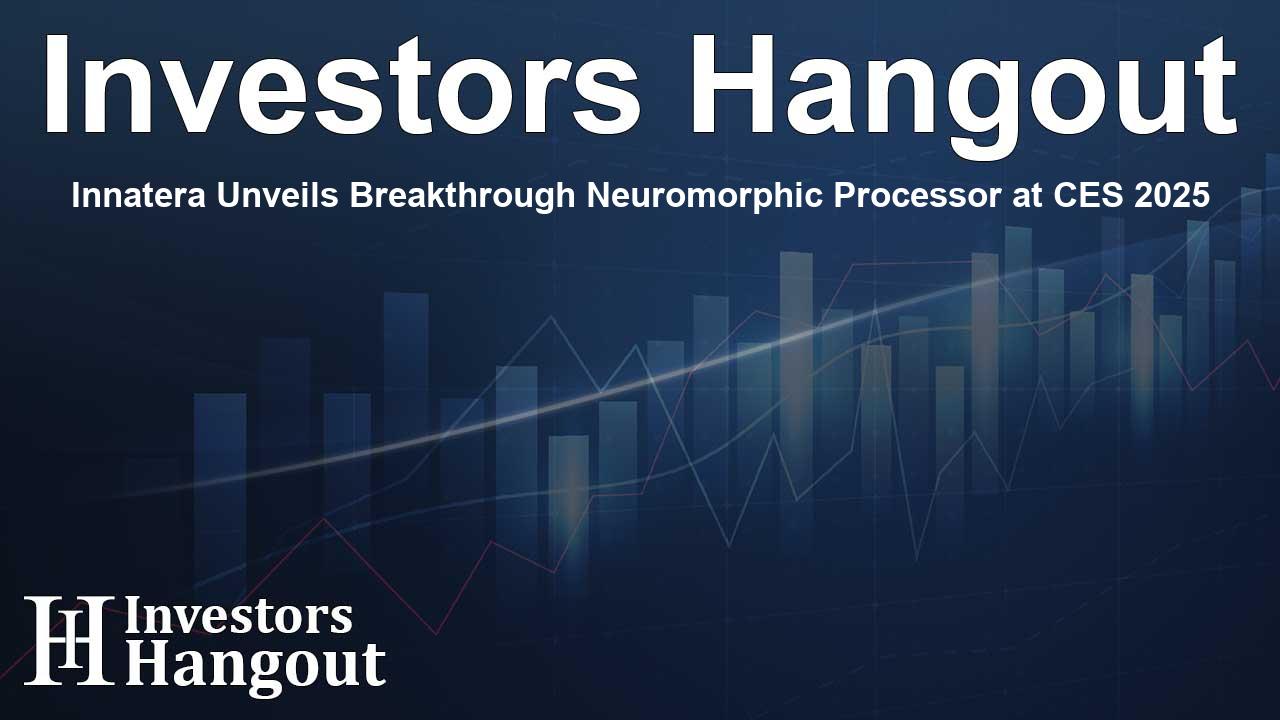Innatera Unveils Breakthrough Neuromorphic Processor at CES 2025

Revolutionizing Ambient Intelligence with Neuromorphic Technology
Innatera, an innovative company emerging from a decade of research at Delft University of Technology, has showcased its transformative Spiking Neural Processor (SNP) at CES 2025. This processor is set to revolutionize the way battery-powered devices interpret and interact with their environment. Utilizing a unique analog-mixed signal computing architecture, the SNP harnesses spiking neural networks to achieve unprecedented levels of brain-like cognition performance while maintaining ultra-low power consumption.
Unlocking New Possibilities in Energy-Efficient Computing
During the demonstrations at CES, Innatera highlighted how its SNP can dramatically improve sensor technology for various applications, from smart home devices to sophisticated industrial IoT systems. Sumeet Kumar, CEO of Innatera, emphasized the capability of the Spiking Neural Processor to enable devices to process data efficiently at the edge, which leads to faster and more intelligent responses.
Breaking Through Energy Constraints
One of the standout features of the SNP is its ability to perform high-performance pattern recognition with sub-milliwatt power dissipation and sub-millisecond latency. This characteristic is particularly important for applications where every bit of energy efficiency counts, such as wearable technology and mobile devices.
Key Applications Demonstrated at CES
At CES 2025, Innatera presented several real-world applications of the SNP that illustrated its capabilities:
- Audio Scene Classification: This application allows devices to adapt based on their surrounding audio environment. For instance, noise-canceling headphones can automatically adjust to reduce distracting background sounds during flights or commutes.
- Robust Human Presence Sensing: The SNP enables privacy-preserving human presence detection, vital for various technologies including security cameras and smart lighting systems. The demonstrations showcased how this detection can work efficiently and accurately.
- People Counting Using Far Infrared Sensors: Innatera illustrated the potential of its technology in advanced people counting scenarios, using non-intrusive infrared sensors that respect user privacy while maintaining accurate results.
These applications are just a glimpse of the future possibilities for ambient intelligence enabled by Innatera's technology.
A Year of Growth and Development
Innatera's presence at CES comes on the heels of an impressive year of growth, driven by the successful oversubscription of a Series A funding round that raised $21 million. This financial boost is pivotal for accelerating the development and deployment of its cutting-edge neuromorphic processors.
Vision for the Future
The company's vision extends beyond just products; Innatera aims to create a landscape where electronic devices seamlessly integrate into everyday life. The mission is clear: to infuse a billion sensors with brain-like intelligence by 2030. This ambitious goal is backed by significant support from leading European deep-tech investors, further solidifying Innatera's role as a key player in the tech industry.
About Innatera
Innatera stands at the forefront of ambient intelligent technology. Born from extensive research on energy-efficient neuromorphic computing, the company seeks to revolutionize how electronic devices operate in our daily lives. By rethinking sensor capabilities with brain-like processing, Innatera envisions a smarter, safer, and cleaner world for everyone, transforming digital interaction into a more natural experience.
Frequently Asked Questions
What is the Spiking Neural Processor (SNP)?
The SNP is an advanced neuromorphic processor designed to deliver energy-efficient, brain-inspired cognition for various applications.
How does the SNP improve energy efficiency?
It combines spiking neural networks with a RISC-V core, optimizing performance in low power environments, allowing for sub-milliwatt dissipation.
What applications can benefit from the SNP?
Smart homes, industrial IoT, health monitoring devices, and more can leverage the SNP for enhanced processing capabilities.
Why is Innatera's technology considered groundbreaking?
By enabling devices to process data at the edge, it transforms how they interact with their environment, making digital interactions more intuitive.
What is Innatera's long-term vision?
Innatera aims to embed brain-like intelligence in a billion sensors by 2030, creating a future with smarter electronic devices.
About Investors Hangout
Investors Hangout is a leading online stock forum for financial discussion and learning, offering a wide range of free tools and resources. It draws in traders of all levels, who exchange market knowledge, investigate trading tactics, and keep an eye on industry developments in real time. Featuring financial articles, stock message boards, quotes, charts, company profiles, and live news updates. Through cooperative learning and a wealth of informational resources, it helps users from novices creating their first portfolios to experts honing their techniques. Join Investors Hangout today: https://investorshangout.com/
Disclaimer: The content of this article is solely for general informational purposes only; it does not represent legal, financial, or investment advice. Investors Hangout does not offer financial advice; the author is not a licensed financial advisor. Consult a qualified advisor before making any financial or investment decisions based on this article. The author's interpretation of publicly available data shapes the opinions presented here; as a result, they should not be taken as advice to purchase, sell, or hold any securities mentioned or any other investments. The author does not guarantee the accuracy, completeness, or timeliness of any material, providing it "as is." Information and market conditions may change; past performance is not indicative of future outcomes. If any of the material offered here is inaccurate, please contact us for corrections.